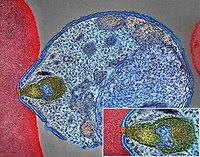
Photo from wikipedia
Introduction The spread of artemisinin resistant Plasmodium falciparum parasites is of global concern and highlights the need to identify new antimalarials for future treatments. Azithromycin, a macrolide antibiotic used clinically… Click to show full abstract
Introduction The spread of artemisinin resistant Plasmodium falciparum parasites is of global concern and highlights the need to identify new antimalarials for future treatments. Azithromycin, a macrolide antibiotic used clinically against malaria, kills parasites via two mechanisms: ‘delayed death’ by inhibiting the bacterium-like ribosomes of the apicoplast, and ‘quick-killing’ that kills rapidly across the entire blood stage development. Methods Here, 22 azithromycin analogues were explored for delayed death and quick-killing activities against P. falciparum (the most virulent human malaria) and P. knowlesi (a monkey parasite that frequently infects humans). Results Seventeen analogues showed improved quick-killing against both Plasmodium species, with up to 38 to 20-fold higher potency over azithromycin after less than 48 or 28 hours of treatment for P. falciparum and P. knowlesi, respectively. Quick-killing analogues maintained activity throughout the blood stage lifecycle, including ring stages of P. falciparum parasites (<12 hrs treatment) and were >5-fold more selective against P. falciparum than human cells. Isopentenyl pyrophosphate supplemented parasites that lacked an apicoplast were equally sensitive to quick-killing analogues, confirming that the quick killing activity of these drugs was not directed at the apicoplast. Further, activity against the related apicoplast containing parasite Toxoplasma gondii and the gram-positive bacterium Streptococcus pneumoniae did not show improvement over azithromycin, highlighting the specific improvement in antimalarial quick-killing activity. Metabolomic profiling of parasites subjected to the most potent compound showed a build-up of non-haemoglobin derived peptides that was similar to chloroquine, while also exhibiting accumulation of haemoglobin-derived peptides that was absent for chloroquine treatment. Discussion The azithromycin analogues characterised in this study expand the structural diversity over previously reported quick-killing compounds and provide new starting points to develop azithromycin analogues with quick-killing antimalarial activity.
Journal Title: Frontiers in Cellular and Infection Microbiology
Year Published: 2022
Link to full text (if available)
Share on Social Media: Sign Up to like & get
recommendations!